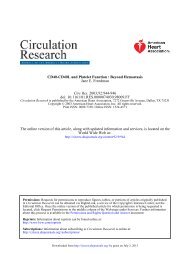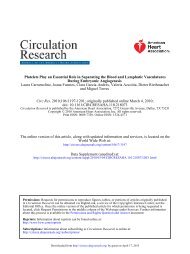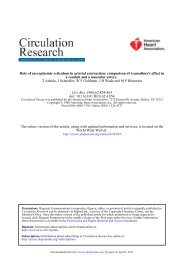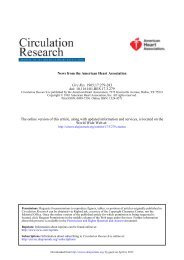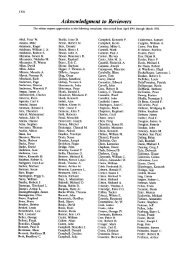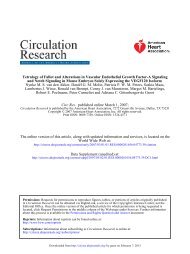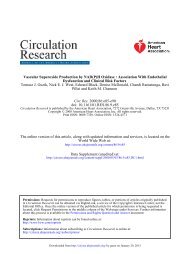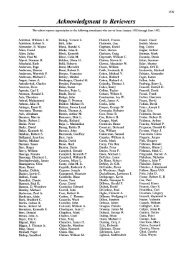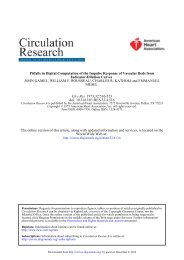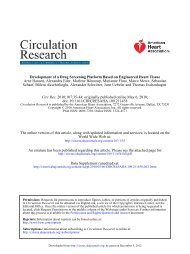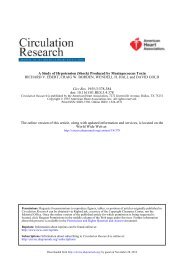Tsuji et. al. amniotic membrane-derived stem cell (2009/205260-R3 ...
Tsuji et. al. amniotic membrane-derived stem cell (2009/205260-R3 ...
Tsuji et. al. amniotic membrane-derived stem cell (2009/205260-R3 ...
Create successful ePaper yourself
Turn your PDF publications into a flip-book with our unique Google optimized e-Paper software.
<strong>Tsuji</strong> <strong>et</strong>. <strong>al</strong>. <strong>amniotic</strong> <strong>membrane</strong>-<strong>derived</strong> <strong>stem</strong> <strong>cell</strong><br />
(<strong>2009</strong>/<strong>205260</strong>-<strong>R3</strong>)<br />
of the EGFP-positive cardiomyocytes was c<strong>al</strong>culated in every tissue slice.<br />
In the present study, the size of EGFP-positive cardiomyocytes are the<br />
same as the host cardiomyocytes; therefore, the average size of the<br />
EGFP-positive cardiomyocytes was postulated as norm<strong>al</strong> mamm<strong>al</strong>ian<br />
ventricular cardiomyocytes (circular cylinder 100 µm in length and 11 µm<br />
in radius, <strong>cell</strong> volume is c<strong>al</strong>culated as 37.994 pL, 3 . Because the<br />
cardiomyocyte array is <strong>al</strong>ong a random direction, the incidence of<br />
appearance in a tissue section is postulated to be the same as the<br />
incidence of appearance, in a single slice, of a sphere of the same<br />
volume (radius 20.9 µm). This suggests that, if we sliced the tissue at<br />
every 41.8 µm, we could observe every EGFP-positive <strong>cell</strong> in the heart.<br />
Therefore, we assume the number of surviving EGFP-positive<br />
cardiomyocytes to be equ<strong>al</strong> to (tot<strong>al</strong> count of EGFP-positive<br />
cardiomyocytes from every slice) x (360/41.8). The rate of surviving<br />
EGFP-positive cardiomyocytes was defined as the number of the<br />
surviving EGFP-positive cardiomyocytes divided by the number of<br />
injected hAMCs.<br />
5. Isolation of transdifferentiated cardiomyocytes and FISH experiment<br />
M<strong>et</strong>hod for isolation of cardiomyocytes was shown in our previous<br />
paper 4 , but with slight modification. Excised heart was perfused<br />
r<strong>et</strong>rogradely, with nomin<strong>al</strong>ly Ca 2+ free Tyrode!s solution (described later)<br />
with 0.1% bovine serum <strong>al</strong>bumin (BSA, fraction-V, Gibco) for 3 minutes,<br />
and then switched to an enzyme solution containing 0.8 g/L of type-II<br />
collagenase (Worthington Biochemic<strong>al</strong>, NJ, USA) and 0.2 % BSA for 25-<br />
30 minutes. Next, the left ventricle was minced, incubated, and gently<br />
agitated in enzyme solution containing 0.8 g/L of the collagenase, 3 %<br />
BSA, and 0.3 mmol/L CaCl 2 . Incubation with fresh enzyme solution was<br />
repeated 7-9 times at 10-minute interv<strong>al</strong>s. The supernatant from each<br />
Suppl 9



